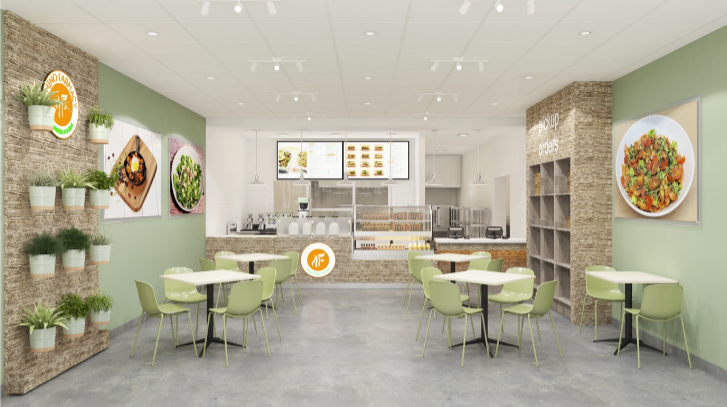
Top 10 sustainable design trends for restaurants and bakeries identified by TNI Design
January 25, 2023
By
Colleen Cross
 HempWood consists of safe, non-toxic hemp composites that serve many purposes, such as counters, wall siding, planters and flooring. Photo: TNI Design
HempWood consists of safe, non-toxic hemp composites that serve many purposes, such as counters, wall siding, planters and flooring. Photo: TNI Design Reclaimed wood, recycled glass, timers and motion sensors for lighting, and LEDs or compact fluorescent lightbulbs are among the top sustainable restaurant and bakery design trends for 2023, according to TNI Design’s Restaurant Interior Design Sustainability Trends.
The report, entitled “Restaurant Interior Design Sustainability Trends 2023,” predicts that restaurants and cafés will begin to advertise at scale how they are actively reducing their environmental footprint through their use of sustainable building materials and deployment of alternative power.
The following excerpts from the report touch on the trends and their specific value to restaurants and bakeries.
Reclaimed wood products have seen a resurgence in demand in large part due to the sustainability of the material. While there are transport costs involved, no tree needs to be culled. By way of example: one of TNI Design’s clients has opted for a 100 per cent reclaimed wood siding for their new interior design. This decision will save around 70 trees per location totalling 5,000 trees for the entire remodel program.
Tiles and slabs created from sustainable bamboo, reclaimed wood, and recycled glass components provide a wonderfully satisfying way to make an impact on their surroundings. These unique, one-of-a-kind materials are made from mirror windows, windshield shards, and demolished architectural glass that have been mixed with a binder to create magnificent terrazzo-type slabs. Not only is this material mix being adopted as floor, wall, and counter finish options, they also deliver stunning aesthetic results in addition to offering important practical benefits of stain resistance and reduced maintenance.
Lighting rooms with no occupants is a major energy waste and can have a significant monthly impact on electricity expenses. Restaurants are moving en masse towards light automation using timers and motion sensors. Moving forward, restaurants have more access to new technology that provides sensors and timers for main areas, resulting in lighting, HVAC, and other energy utilization only as needed and with substantial waste removal. These strategies enable restaurants to cut back on energy waste relating to lighting, general power and equipment.
LED and CFL bulbs use less energy than traditional lightbulbs, thus represent an obvious choice for reducing energy waste. When it comes to efficiency, CFLs use about one fourth the amount of energy of a regular bulb but last 10 times longer.
HempWood consists of safe, non-toxic hemp composites that serve many purposes, such as counters, wall siding, planters and flooring. It is being adopted for a variety of construction and decoration uses in restaurants. Restaurants are now able to engage mass production and order fulfilment for this unique material. The use of a multitude of eco-friendly hemp materials has given birth to sustainable design and finish materials of increasing quality.
Restaurants are using bamboo in table tops, chairs, wall siding, and flooring, as well as operational execution such as disposable bamboo cutlery. The adoption is growing where demand is higher than supply, thus resulting in a dominant sustainable trend in the hospitality sectors.
The sustainable design company’s clients include Westfield, EggSlut, Viva Vegan, Pizzaro, Paris Baguette, Gustoso and Phood Pharmacy. The report’s author is Robert Ancill, CEO of TNI Design and The Next Idea Group.
Print this page
Leave a Reply